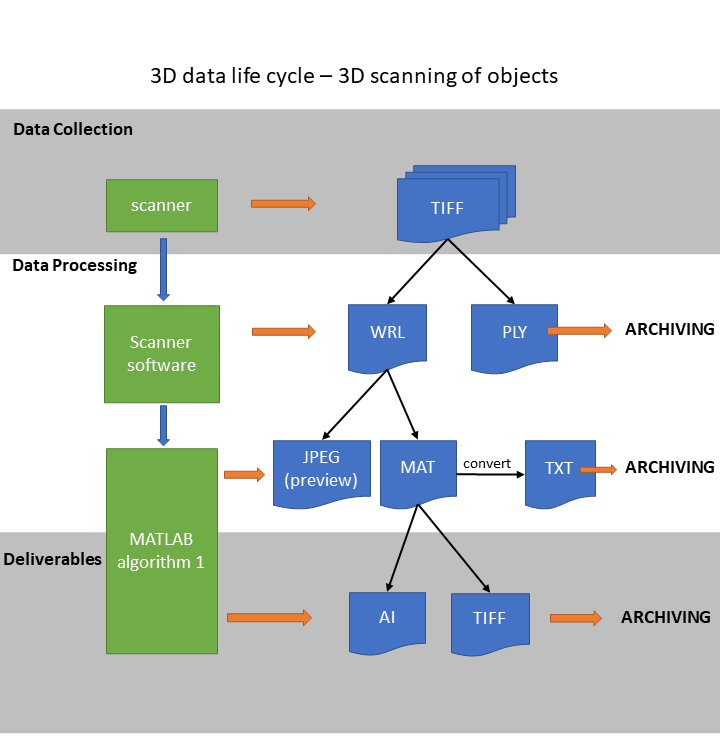Difference between revisions of "Workflow:Archiving outputs of 3D scanning"
| Line 17: | Line 17: | ||
==Purpose, Context and Content== | ==Purpose, Context and Content== | ||
<!-- Describe what your workflow is for - i.e. what it is designed to achieve, what the organisational context of the workflow is, and what content it is designed to work with --> | <!-- Describe what your workflow is for - i.e. what it is designed to achieve, what the organisational context of the workflow is, and what content it is designed to work with --> | ||
| − | + | The workflow documents the process of creating 3D models (of objects) and their derivatives by a stereo-scanner, and specifies which outputs can and need to be archived. | |
| + | 1. Data acquisition - scanning (and archiving?) | ||
| + | 2. Data processing | ||
| + | 2.1 Generating and archiving 3D mesh | ||
| + | 2.2 Positioning of the object based on its geometric properties | ||
| + | 3. Output - generating and archiving standard drawings or set of views on the model. | ||
==Evaluation/Review== | ==Evaluation/Review== | ||
<!-- How effective was the workflow? Was it replaced with a better workflow? Did it work well with some content but not others? What is the current status of the workflow? Does it relate to another workflow already described on the wiki? Link, explain and elaborate --> | <!-- How effective was the workflow? Was it replaced with a better workflow? Did it work well with some content but not others? What is the current status of the workflow? Does it relate to another workflow already described on the wiki? Link, explain and elaborate --> | ||
| Line 23: | Line 28: | ||
==Further Information== | ==Further Information== | ||
<!-- Provide any further information or links to additional documentation here --> | <!-- Provide any further information or links to additional documentation here --> | ||
| − | + | Scanner software: https://www.polymetric.de/index.php?id=44&L=2 | |
| + | Core publications: | ||
| + | Karasik, A. and Smilansky U. 2011. Computerized morphological classification of ceramics. Journal of Archaeological Science 38(10):2644-2657. | ||
| + | Karasik, A. and Smilansky U. 2008. 3D scanning technology as a standard archaeological tool for pottery analysis: practice and theory. Journal of Archaeological Science 35(5):1148-1168. | ||
<!-- Add four tildes below ("~~~~") to create an automatic signature, including your wiki username. Ensure your user page (click on your username to create it) includes an up to date contact email address so that people can contact you if they want to discuss your workflow --> | <!-- Add four tildes below ("~~~~") to create an automatic signature, including your wiki username. Ensure your user page (click on your username to create it) includes an up to date contact email address so that people can contact you if they want to discuss your workflow --> | ||
<!-- Note that your workflow will be marked with a CC3.0 licence --> | <!-- Note that your workflow will be marked with a CC3.0 licence --> | ||
[[User:Sveti1|Sveti1]] ([[User talk:Sveti1|talk]]) 14:29, 28 February 2022 (UTC) | [[User:Sveti1|Sveti1]] ([[User talk:Sveti1|talk]]) 14:29, 28 February 2022 (UTC) | ||
Revision as of 15:59, 28 February 2022
Workflow Description
Purpose, Context and Content
The workflow documents the process of creating 3D models (of objects) and their derivatives by a stereo-scanner, and specifies which outputs can and need to be archived. 1. Data acquisition - scanning (and archiving?) 2. Data processing 2.1 Generating and archiving 3D mesh 2.2 Positioning of the object based on its geometric properties 3. Output - generating and archiving standard drawings or set of views on the model.
Evaluation/Review
Further Information
Scanner software: https://www.polymetric.de/index.php?id=44&L=2 Core publications: Karasik, A. and Smilansky U. 2011. Computerized morphological classification of ceramics. Journal of Archaeological Science 38(10):2644-2657. Karasik, A. and Smilansky U. 2008. 3D scanning technology as a standard archaeological tool for pottery analysis: practice and theory. Journal of Archaeological Science 35(5):1148-1168.
